We are off to the jungle! Its is just before noon in beautiful Cusco as our StarPeru jet lifts off bound for Puerto Maldonado, Peru for our four-day exploration of the Peruvian rainforest.
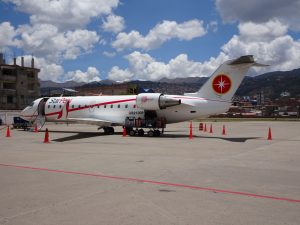
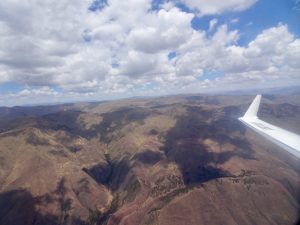 The undulating mountains of the Andes have little to no
The undulating mountains of the Andes have little to no
vegetation as we pass over them.
There is nothing much in them perhaps an occasional small village in a valley.
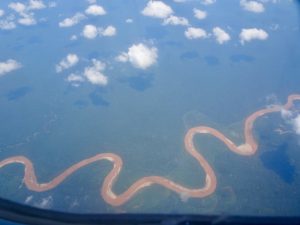
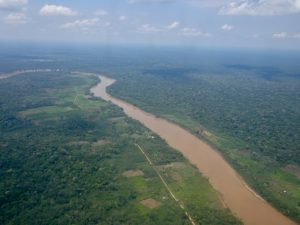 Then appears the rain forest, dense with green and muddy tributaries of the Amazon River flowing throughout. The forest is massive with dense trees and jungle as far as the eye can see. Sixty percent of Peru is covered by the Amazon rainforest, while only 5 percent of the Peru population lives there!
Then appears the rain forest, dense with green and muddy tributaries of the Amazon River flowing throughout. The forest is massive with dense trees and jungle as far as the eye can see. Sixty percent of Peru is covered by the Amazon rainforest, while only 5 percent of the Peru population lives there!
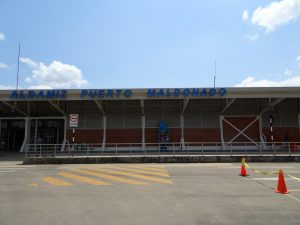
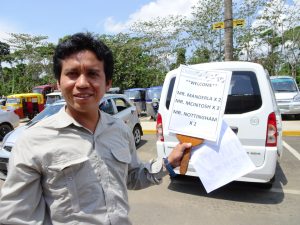 The flight time is short, approximately 30 minutes , putting us in Puerto Maldonado around 12:30. We are welcomed by our guide, driver, and Florida-like weather….probably close to 90 degrees and 100 percent humidity. The great news is we are much closer to sea-level!
The flight time is short, approximately 30 minutes , putting us in Puerto Maldonado around 12:30. We are welcomed by our guide, driver, and Florida-like weather….probably close to 90 degrees and 100 percent humidity. The great news is we are much closer to sea-level!
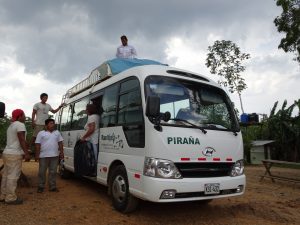
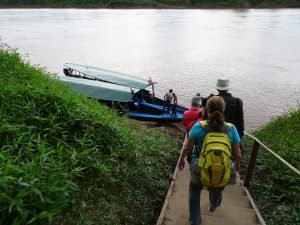 We make a brief stop at the company hosting our visit in the Amazon rainforest to check in, then a short bus ride and ultimately to a pier where our boat to take us down the Tambopata River is waiting.
We make a brief stop at the company hosting our visit in the Amazon rainforest to check in, then a short bus ride and ultimately to a pier where our boat to take us down the Tambopata River is waiting.
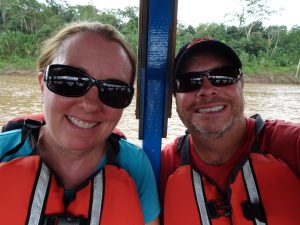
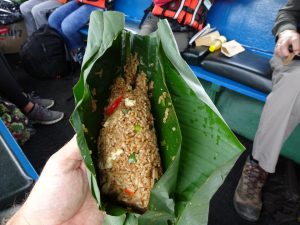 It looks like we will be well-fed. On the bus we are given a small woven basket with bananas. On the boat we are served up what is like a fried rice wrapped in a banana leaf along with a papaya type juice.
It looks like we will be well-fed. On the bus we are given a small woven basket with bananas. On the boat we are served up what is like a fried rice wrapped in a banana leaf along with a papaya type juice.
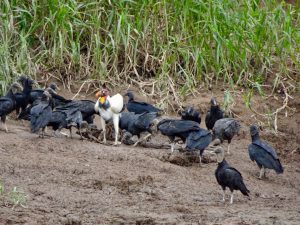
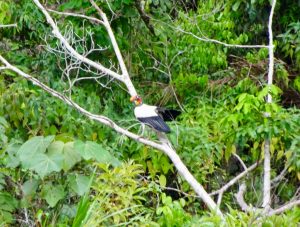 The boat ride reminds us a bit of our trip down the Mekong River in Laos earlier this year, minus the mountains. Also there are no elephants, lol. However, on our two and a half hour journey down the Tambopata River we are already lucky to see some of the area wildlife. There is a flock of black vultures eating on the carcass of a capybara that apparently a puma had killed days earlier. What is interesting is that in the middle of them is a king vulture. It is a very large bird mostly white, some black and a very colorful head and beak…and beady eyes.
The boat ride reminds us a bit of our trip down the Mekong River in Laos earlier this year, minus the mountains. Also there are no elephants, lol. However, on our two and a half hour journey down the Tambopata River we are already lucky to see some of the area wildlife. There is a flock of black vultures eating on the carcass of a capybara that apparently a puma had killed days earlier. What is interesting is that in the middle of them is a king vulture. It is a very large bird mostly white, some black and a very colorful head and beak…and beady eyes.
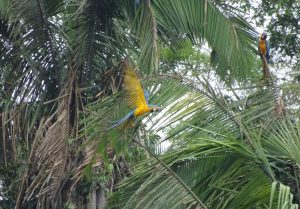
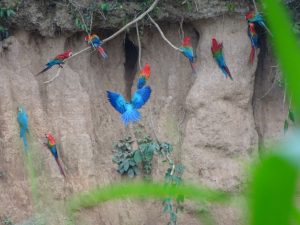 Just a bit down the river is a flock of macaws eating clay. Apparently it is good for their digestive system, which they eat after consuming berries.
Just a bit down the river is a flock of macaws eating clay. Apparently it is good for their digestive system, which they eat after consuming berries.
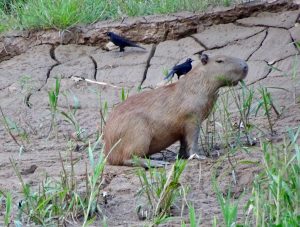 The wildlife viewing is not over yet. We come up the largest rodent in the world, the capybara. There is actually a family of them, maybe five or six of them.
The wildlife viewing is not over yet. We come up the largest rodent in the world, the capybara. There is actually a family of them, maybe five or six of them.
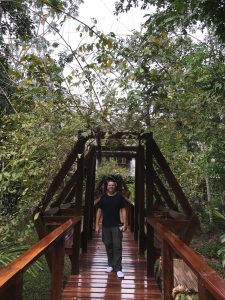 About another 30 minutes up the river and we arrive at our “port”. It is another 15 minute walk, part uphill to the beautiful refugios! Amazonas Refugios! It is amazing!
About another 30 minutes up the river and we arrive at our “port”. It is another 15 minute walk, part uphill to the beautiful refugios! Amazonas Refugios! It is amazing!
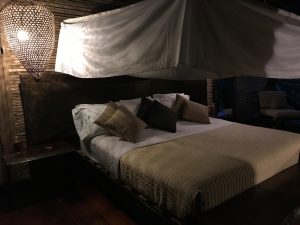 We are given a warm reception with a cool towel, queso sandwich and drink. Ee are given an overview of the Refugios including when there is electric, the upcoming activities and importantly, eating schedule. Then we are off to our room. The room is amazing!
We are given a warm reception with a cool towel, queso sandwich and drink. Ee are given an overview of the Refugios including when there is electric, the upcoming activities and importantly, eating schedule. Then we are off to our room. The room is amazing!
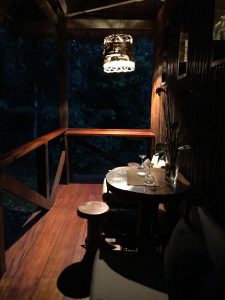
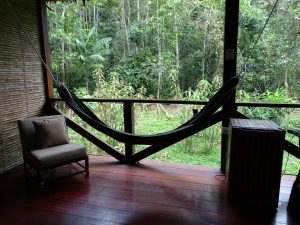 The rooms are basically open from a ventilation perspective. One side is totally open to the jungle. The eves and front porch are open as well. The rooms are all wood, a hammock, and a mosquito net over our king size bed.
The rooms are basically open from a ventilation perspective. One side is totally open to the jungle. The eves and front porch are open as well. The rooms are all wood, a hammock, and a mosquito net over our king size bed.
We attend a lecture at 6:30 provided by a young biologist, Nicole. She describes the wildlife in the area, jaguar, puma, anteaters, monkeys, capybara, deer, many birds and more! There are hundreds of cameras set up in the Amazon to observe wildlife. Some around the resort pick up the jaguar hanging out nearby at night. Occasionally the monkeys figure out the cameras and I suppose do not like their picture taken. They are curious and end up destroying them!
Nicole also talks about an organization of “citizen scientists” that help to monitor wildlife. There is an organization called zooniverse.com where anyone can sign up and help record observations. Sounds very cool.
Friday
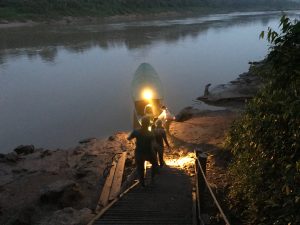 We are up at 4 am and on our way through the dark jungle to our boat. It is an hour and a half to the clay salt lick where we will see hundreds of Macaws. We hesitated to do this expedition since we saw macaws yesterday on our way into the jungle.
We are up at 4 am and on our way through the dark jungle to our boat. It is an hour and a half to the clay salt lick where we will see hundreds of Macaws. We hesitated to do this expedition since we saw macaws yesterday on our way into the jungle.
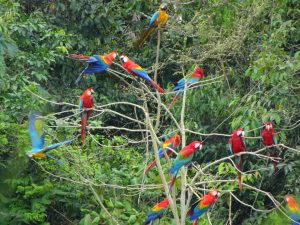
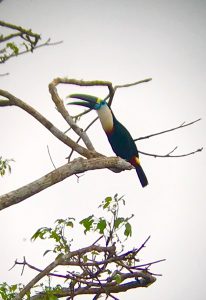 We arrive to a chorus of macaws, hundreds maybe thousands. We also see at least two toucans.
We arrive to a chorus of macaws, hundreds maybe thousands. We also see at least two toucans.
All so beautiful. Our guides bring us breakfast, buns, queso, avocados, jam, coffee and teas. We are surrounded by bees and their buzzing but they are soon muted by the screeching of macaws.
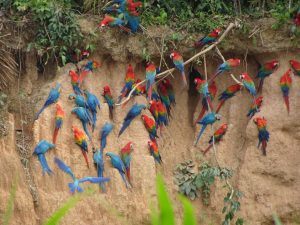
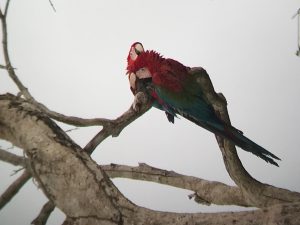 Occasionally the macaws are spooked by perhaps a predator and fly off by the dozens. It is quite a site to see the large group fly and scream! Their natural predators are the monkey, jaguar and vultures.
Occasionally the macaws are spooked by perhaps a predator and fly off by the dozens. It is quite a site to see the large group fly and scream! Their natural predators are the monkey, jaguar and vultures.
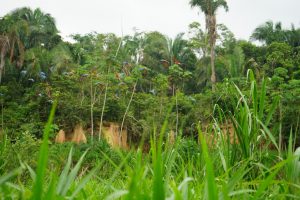 We hang out here for about three hours, then board the boat to go find some jaguar. No luck spotting any on the way back but do see heron, egret, duck and other fowl.
We hang out here for about three hours, then board the boat to go find some jaguar. No luck spotting any on the way back but do see heron, egret, duck and other fowl.
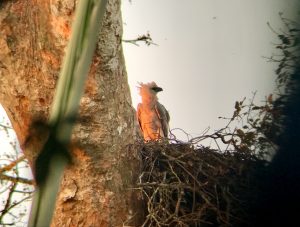 We take a brief siesta back at the lodge midday. In the late afternoon we trek about 30 minutes into the forest to a nest…that of the Harpy Eagle. The nest is high up in a large tree that towers above the rain forest. We are told some people travel here just to see these eagles.
We take a brief siesta back at the lodge midday. In the late afternoon we trek about 30 minutes into the forest to a nest…that of the Harpy Eagle. The nest is high up in a large tree that towers above the rain forest. We are told some people travel here just to see these eagles.
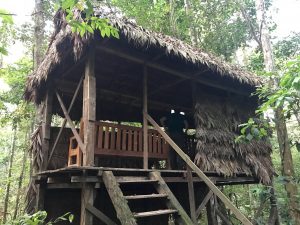 There are a couple ways to observe the nest. The research center has set up a camera in a nearby tree. There is a stand in the forest that has a monitor set up, hooked to a series of car batteries. Here we are able to watch the ten week old eagle in the nest. It is apparently still eating on a meal that the parents provided, a monkey. We learn that the chick will stay in the nest for up to two years until booted out by the parents.
There are a couple ways to observe the nest. The research center has set up a camera in a nearby tree. There is a stand in the forest that has a monitor set up, hooked to a series of car batteries. Here we are able to watch the ten week old eagle in the nest. It is apparently still eating on a meal that the parents provided, a monkey. We learn that the chick will stay in the nest for up to two years until booted out by the parents.
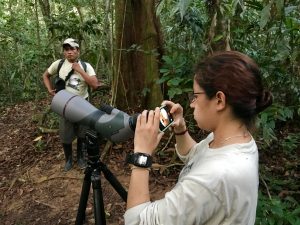 The second way to observe is through the telescope. We are also able to take photos through the lens of the scope. We have an excellent view of the chick from this vantage point.
The second way to observe is through the telescope. We are also able to take photos through the lens of the scope. We have an excellent view of the chick from this vantage point.
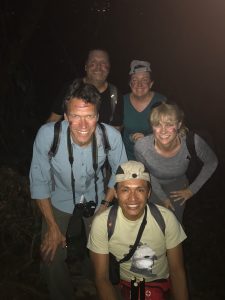 The walk back to the resort is a bit quicker as it is in the dark! We do stop and crush some leaves of a local plant. The result when the green leaves are mixed with some water is a blood-red ointment. It is used for camouflage as well as a natural mosquito repellent. Our guide paints our faces with it, lol.
The walk back to the resort is a bit quicker as it is in the dark! We do stop and crush some leaves of a local plant. The result when the green leaves are mixed with some water is a blood-red ointment. It is used for camouflage as well as a natural mosquito repellent. Our guide paints our faces with it, lol.
Saturday
Five thirty a.m. and the sweet jungle is alive with sounds. The insects and animals come alive in a chorus seemingly about 20 minutes before sunset and 20 minutes before sunrise, the wakeup call!
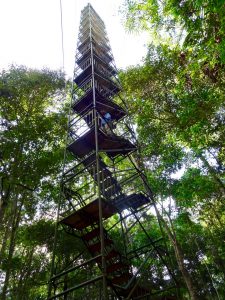
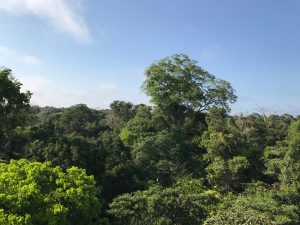 After breakfast we are off to climb the canopy tower. It is a short ten minute walk to the tower, but the twelve story walk up the tower is not good for someone with a growing fear of heights. I make it up to the top to catch a glimpse of the canopy top and snap a couple of pics. That is enough for me!
After breakfast we are off to climb the canopy tower. It is a short ten minute walk to the tower, but the twelve story walk up the tower is not good for someone with a growing fear of heights. I make it up to the top to catch a glimpse of the canopy top and snap a couple of pics. That is enough for me!
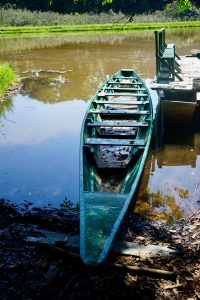
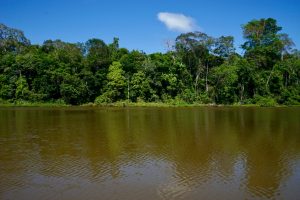 Once down the tower we hike to a small beautiful lake, an oxbow lake they call them here. We hop aboard a canoe that holds all six of us. Our wonderful guide, Flor, does most of the paddling and steering aided occasionally by Alan, who is from Toronto with his wife Susan.
Once down the tower we hike to a small beautiful lake, an oxbow lake they call them here. We hop aboard a canoe that holds all six of us. Our wonderful guide, Flor, does most of the paddling and steering aided occasionally by Alan, who is from Toronto with his wife Susan.
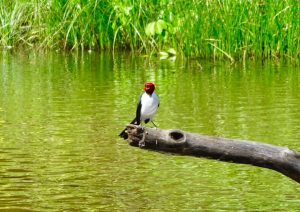
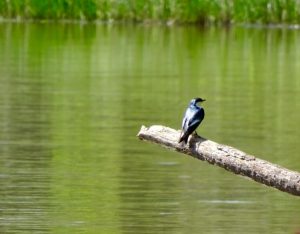 We see some beautiful birds including a red capped cardinal and many variety of butterfly.
We see some beautiful birds including a red capped cardinal and many variety of butterfly.
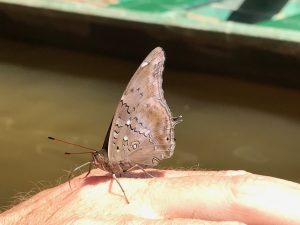
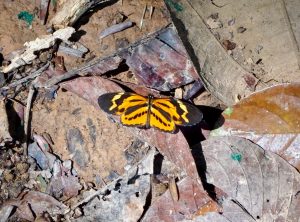 The butterflies seem quite tame as one wants to hang out on my hand for a while! The vegetation of the area is beautiful as well, and reminds us a bit of the rainforest in Australia and New Zealand.
The butterflies seem quite tame as one wants to hang out on my hand for a while! The vegetation of the area is beautiful as well, and reminds us a bit of the rainforest in Australia and New Zealand.
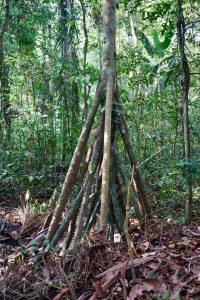
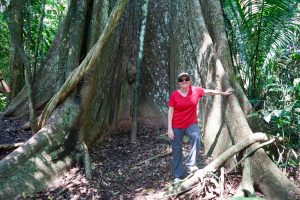 We see two enormous strangler fig trees in the area, probably four or five hundred years old each. There are also towering brazil nut trees, huge birds of paradise and towering palms. There are numerous walking trees that actually “move” as the tree reroots. Apparently these trees can “walk” up to 20 meters per year as it constantly seeks more sunlight.
We see two enormous strangler fig trees in the area, probably four or five hundred years old each. There are also towering brazil nut trees, huge birds of paradise and towering palms. There are numerous walking trees that actually “move” as the tree reroots. Apparently these trees can “walk” up to 20 meters per year as it constantly seeks more sunlight.
A very interesting ant is the cutter ant. They have quite an organization for kings, queens and workers. They actually “cut” and “carry” leaves. They are able to devour an entire tree of its leaves in 24 hours! We see rows of the ants going in two lines. One line is going in one direction with cut leaves on their back. The second line of ants is going in the opposite direction to go cut leaves and carry them back. Amazing!
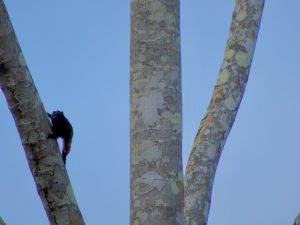 On the return we stop and observe more monkeys. It is a hot day and we are glad to return to the Refugio before noon for some cold jungle tomato juice and cake!
On the return we stop and observe more monkeys. It is a hot day and we are glad to return to the Refugio before noon for some cold jungle tomato juice and cake!
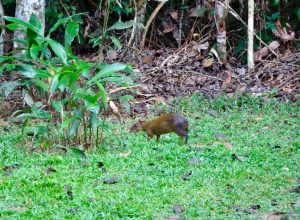 We also spot the Agouti just outside of our resort. The agouti is a small rodent that eats brazil nuts. Yes, it is the only animal with teeth strong enough to crack a brazil nut. Some monkeys have been known to open the nuts with a rock!
We also spot the Agouti just outside of our resort. The agouti is a small rodent that eats brazil nuts. Yes, it is the only animal with teeth strong enough to crack a brazil nut. Some monkeys have been known to open the nuts with a rock!
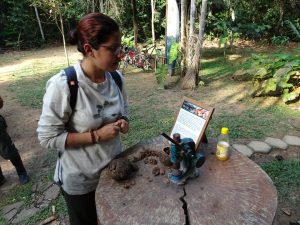
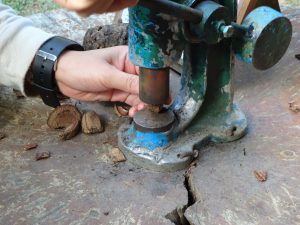 The brazil nut is very important to the region. Economically it provides many jobs in the area as most of the nuts are exported. The nuts are actually produced from a “fruit” on the brazil nut-tree. Each fruit contains 8 – 24 nuts. Harvesting these nuts is quite a laborious process. I am able to sample some!
The brazil nut is very important to the region. Economically it provides many jobs in the area as most of the nuts are exported. The nuts are actually produced from a “fruit” on the brazil nut-tree. Each fruit contains 8 – 24 nuts. Harvesting these nuts is quite a laborious process. I am able to sample some!
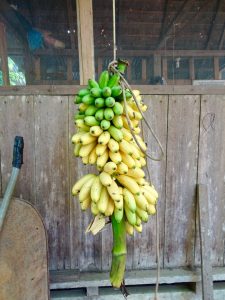
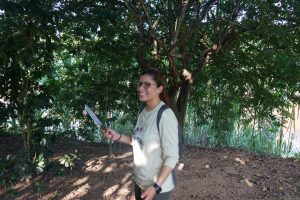 After lunch and a siesta, I visit a nearby farm with Flor across the Tambopata River. Along the path to the river I am startled by a group of large boar. I was thinking perhaps it was a Jaguar and my first instinct was to jump behind my guide Flor. I am sure I scared, her more than the boar.
After lunch and a siesta, I visit a nearby farm with Flor across the Tambopata River. Along the path to the river I am startled by a group of large boar. I was thinking perhaps it was a Jaguar and my first instinct was to jump behind my guide Flor. I am sure I scared, her more than the boar.
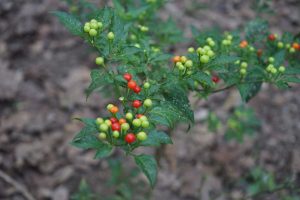
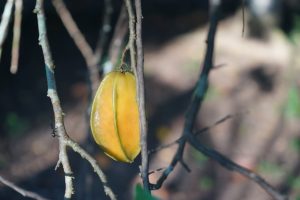 The farm is very cool. It is farmed in a way that is in harmony with the forest. The land is not burned for clearing and the crops are rotated. The fruit, vegetables and plants are abundant on the farm with many varieties. Flor prepares samples picked right from the trees and plants for tasting.
The farm is very cool. It is farmed in a way that is in harmony with the forest. The land is not burned for clearing and the crops are rotated. The fruit, vegetables and plants are abundant on the farm with many varieties. Flor prepares samples picked right from the trees and plants for tasting.
We enjoy our last dinner with Alan and Susan from Toronto and our guide Flor. During the night around midnight, we hear what seems perhaps to be a large “cat” sound. Perhaps a jaguar? No it is a large bird that looks a bit like a large owl, a Great Potoo.
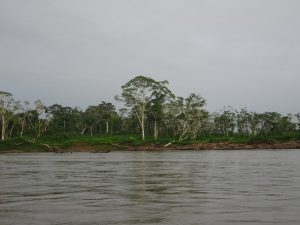
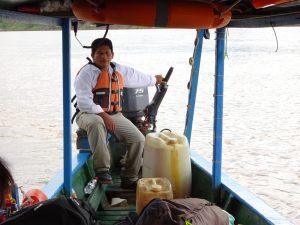 It’s an early boat ride, 6:15 am, down the Tambopata River to Puerto Maldonado. It is here we catch our 10:25 am plane back to Cusco. Our first trip to the Amazon rainforest is spectacular and one that will always have a good memory in our hearts and minds!
It’s an early boat ride, 6:15 am, down the Tambopata River to Puerto Maldonado. It is here we catch our 10:25 am plane back to Cusco. Our first trip to the Amazon rainforest is spectacular and one that will always have a good memory in our hearts and minds!
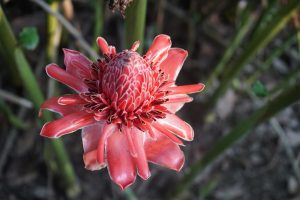
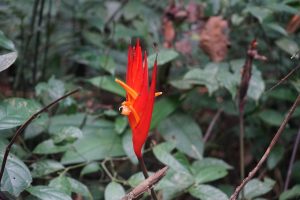
We so enjoyed meeting you at Rose and Gigi’s. I’m looking forward to following your adventures and reading about your past adventures. Happy trails to you til we meet again .
Libbie and Deb
Thanks so much Libbie and Deb! We enjoyed meeting you both as well and enjoyed the conversation. Let’s keep in touch! Mike and Tracey